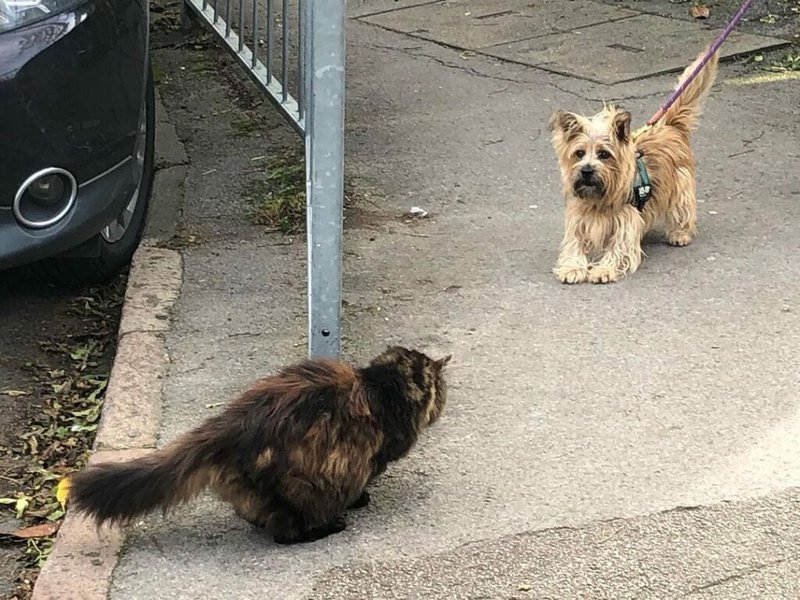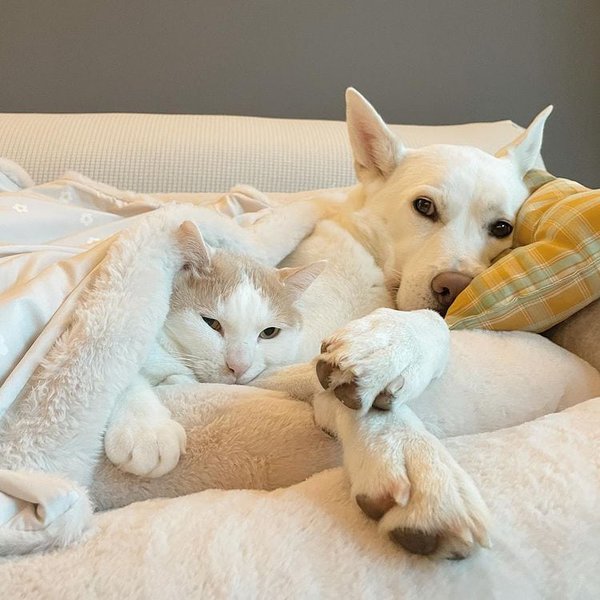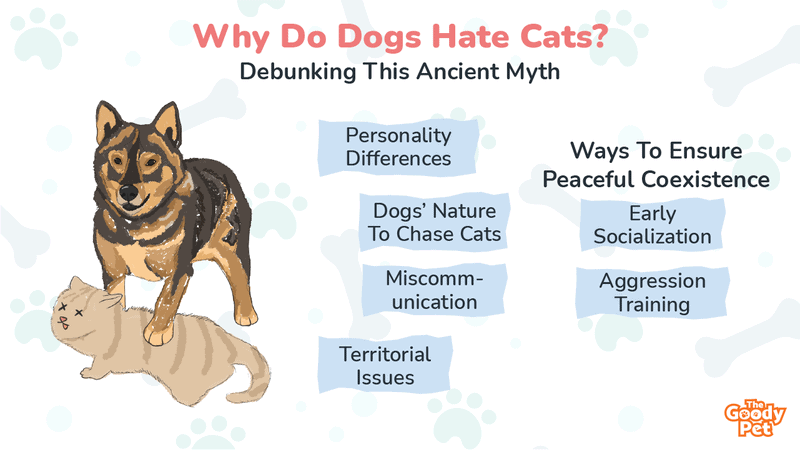One common misconception that has gained widespread belief over the years is the supposed hate relationship that exists between dogs and cats, and this belief has been reinforced by popular media. So, why do dogs hate cats?
Contrary to popular belief, dogs actually do not hate cats. However, due to certain personality differences, like the level of bravery and independence, cats and dogs can have a strained relationship, making it seem like they hate each other.
When and if properly trained and socialized, there is no reason for dogs and cats not to get along well with each other, and this school of thought is further reinforced by the numerous canine-feline friendships we’ve seen blossom around us. If, however, you have a dog-cat pair that aren’t on friendly terms with each other, all hope isn’t lost, and there are steps outlined in this article that you can take to mend the relationship between both animals. However, before we go further, let’s look at some of the reasons why it seems as if dogs hate cats.
Why Do Dogs Hate Cats?

Dogs do not hate cats, but incidents such as a pooch acting out on its natural instincts to chase small, fast-moving animals, miscommunication, and territorial issues can cause dogs and cats to have a non-cordial relationship.
It’s In A Dog’s Nature To Chase
Dogs, by nature, are designed to chase after smaller animals; Hence, a pooch that hasn’t been properly socialized will most likely follow its natural instincts and chase after any small animal it comes across, including cats.
All dogs have a prey drive – some more than others – and cats also instinctively know to run when being chased. And when a dog with a high prey drive encounters a cat that’s always ready to flee, there’s almost always only one outcome.
What Dogs Are More Likely To Chase After Cats?
Now that we’ve established that dogs have a tendency to chase after cats due to their high prey drive, it is important to note that some dog breeds have a higher prey drive, and this information can come in handy when building cat-dog relationships.
Dogs that have a history of being used for hunting small prey and herd cattle or sheep, such as the Australian Cattle Dog, American Foxhound, and Greyhound typically have a higher prey drive. And these pooches are more likely to chase after cats compared to milder dog breeds such as Golden Retrievers and Collies.
Poor Communication
Both dogs and cats communicate with friends and family via body language, and it is quite likely that a pooch might interpret a cat’s body language differently and vice versa.
Dogs typically greet each other by sniffing butts, but a cat may interpret a dog trying to sniff its butt differently, back off, and in the process, provoke an aggressive reaction from the dog with good intentions.
Similarly, when it is time to play, dogs can become very excited. They will jump around and bark wildly. Cats, by nature, are more reserved, and they may mistake the dog’s barking and jumping around for aggression, thereby leading them to become tense and straining the relationship between both animals.
These scenarios frequently occur between dogs and cats that aren’t familiar with each other or that are meeting for the first time.
Territorial Behavior
Both dogs and cats are territorial by nature, and in a household with both as pets, you’ll most likely witness fights, as well as behavior such as urine marking, between both animals, when one animal feels the other animal is encroaching on its territory.
How Can I Get My Dog To Like My Cat?

You can ensure peaceful coexistence between your cat and your dog by teaching the pooch to live peacefully with dogs from an early age, and retraining the dog to correct its aggression against cats.
Cats and dogs can definitely get along well, and we’ve seen several cases where cats and dogs have gone on to develop strong bonds and even become best of friends.
That said, if you wish for this type of cordial relationship to exist between your fido and cat, outlined below are some practical steps for you to carry out:
Early Socialization
The surest way of preventing the bad blood between your dog and cat is by training the dog to coexist peacefully with its feline buddies from a relatively early age.
Socialize the puppy properly by regularly exposing it to cats as early as possible. Puppies are very much open to exploring new experiences during the first few months of their lives and are unlikely to hurt anyone or other animals during this time, which makes it the ideal period to teach them to be friendly to cats.
It also helps to reward your puppy with a treat every time it encounters a cat, as by doing so, you’re teaching the pooch to associate the presence of cats with positive feelings.
Training
If you own a dog that has a tendency to chase after cats, you can limit your dog’s aggression towards its feline counterparts by retraining such a dog. Admittedly, retraining a dog with aggressive tendencies towards cats is no easy feat, but this can be achieved with patience and dedication.
That said, it will be easier to retrain your dog to coexist peacefully with cats by employing the services of a professional dog trainer. But if you’re determined to achieve peaceful coexistence between your dog and cat without external help, you can start out by following the steps outlined below:
- Establish a safe distance between your dog and cat; This safe distance is how close your cat can get to your pooch without provoking an aggressive reaction, and it can be determined via a simple trial and error method.
- Once this safe distance has been determined, keep your cat away from the dog by this distance and click your training clicker.
- Reward your pooch for good behavior by offering it treats.
- Repeat this procedure several times a week, and ensure to give your dog a treat thereafter.
- Decrease the safe distance between your pooch and cat every week, and continue making use of the training clicker; You also shouldn’t forget to offer your dog treats to reward gentle behavior towards the cat.
- Continue the procedures listed above until your cat can come close to your dog without a visible, aggressive reaction from the pooch.
Don’t Overlook The Cat
Dogs aren’t the only troublemakers, and it is also quite possible for cats to perform certain actions to carry out certain actions that will trigger an aggressive reaction in dogs.
Hence, when monitoring an interaction between your cat and dog, pay equal attention to both pets, and ensure that your cat isn’t harassing your pooch.
Make It Possible For Your Cat To Escape
As we’ve mentioned earlier, retraining a dog with a history of aggression towards a cat will take time; Hence, while the training is ongoing, you should create avenues for the cat to escape easily, in the case of attacks from the dog.
Cats are great climbers, and by providing perches at strategic locations around the home, you are making it possible for the cat to climb and evade attacks from the dog.
Pay Equal Attention To Both Animals
It is also quite likely for a dog to become hostile towards a cat if it notices that you’re paying more attention to the cat. Hence, to prevent this from happening, it is advisable that you pay equal attention to each pet and play with them separately.





